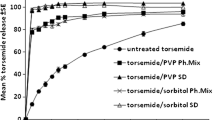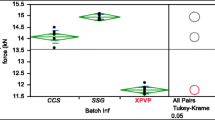Abstract
Drugs formulated as tablets are subjected to accelerated stability conditions with the goal of identifying a stable formulation that will exhibit a sufficiently long shelf life. Water sorption at a condition such as 40°C/75% RH can result in significant changes in tablet properties such as a decrease in dissolution rate, the cause of which may be difficult to interpret, given the complex nature of ingredients and their interactions in a tablet. In this research, three drugs, displaying a wide range of physicochemical properties, were formulated with commonly used diluents, disintegrants, and binders, using a design of experiments approach. The tablets were stored at accelerated conditions and assessed for content, dissolution, disintegration, and crushing strength, as well as other properties. The research demonstrated many water-induced effects in tablet properties. Due to the experimental design approach that revealed many interactions, it was possible to interpret all of the changes observed in tablet crushing strength, disintegration, and dissolution for the drugs using a common set of physical principles. Specifically, the relevant factors considered were (1) mechanical properties of materials, (2) water sorption surface effects in surface diffusion and capillary condensation, (3) water sorption bulk effects for amorphous materials such as viscous flow/spreading, and (4) water-induced stress on interparticle bonding arising from volume expansion. These physical principles enable a comprehensive interpretation of the complex changes observed in tablet properties, which should be valuable in the design of tablet formulations that will be stable to accelerated storage conditions.







Similar content being viewed by others
References
Chowhan ZT, Palagyi L. Hardness increase induced by partial moisture loss in compressed tablets and its effect on in vitro dissolution. J Pharm Sci. 1978;67(10):1385–9.
Chowhan ZT. Moisture, hardness, disintegration and dissolution interrelationships in compressed tablets prepared by the wet granulation process. Drug Dev Ind Pharm. 1979;5(1):41–62.
Chowhan ZT. The effect of low- and high-humidity ageing on the hardness, disintegration time and dissolution rate of dibasic calcium phosphate-based tablets. J Pharm Pharmacol. 1980;32:10–4.
Molokhia AM, Al-Shora HI, Hammad AA. Aging of tablets prepared by direct compression of bases with different moisture content. Drug Dev Ind Pharm. 1987;13(9–11):1933–46.
Chowhan ZT. Role of binders in moisture-induced hardness increase in compressed tablets and its effect on in vitro disintegration and dissolution. J Pharm Sci. 1980;69(1):1–4.
Sarisuta N, Parrott EL. Effects of temperature, humidity and aging on the disintegration and dissolution of acetaminophen tablets. Drug Dev Ind Pharm. 1988;14(13):1877–81.
Lausier JM, Chiang C, Zompa HA, Rhodes CT. Aging of tablets made with dibasic calcium phosphate dihydrate as matrix. J Pharm Sci. 1977;66(11):1636–7.
Schepky G, Fischer M. Effect of production-related variations in hardness and moisture content on the sorption characteristics of tablets. Eur J Pharm Biopharm. 1993;39(2):53–60.
Li S, Wei B, Fleres S, Comfort A, Royce A. Correlation and prediction of moisture-mediated dissolution stability for benazepril hydrochloride tablets. Pharm Res. 2004;21(4):617–24.
Khan KA, Rhodes CT. Water-sorption properties of tablet disintegrants. J Pharm Sci. 1975;64(3):447–51.
Desai PM, Liew CV, Heng PWS. Review of disintegrants and the disintegration phenomena. J Pharm Sci. 2016;105:2545–55.
Bolhuis GK, van Kamp HV, Lerk CF, Sessink FGM. On the mechanism of action of modern disintegrants. Acta Pharm Technol. 1982;28(2):111–4.
Rudnic EM, Rhodes CT, Welch S, Bernardo P. Evaluations of the mechanism of disintegrant action. Drug Dev Ind Pharm. 1982;8(1):87–109.
Quadir A, Kolter K. A comparative study of current superdisintegrants. Pharm Technol. 2006;2006(5):1–5.
Thibert R, Hancock BC. Direct visualization of superdisintegrant hydration using environmental scanning electron microscopy. J Pharm Sci. 1996;85(11):1255–8.
Colombo P, Conte U, Caramella C, Geddo M, Manna A. Disintegrating force as a new formulation parameter. J Pharm Sci. 1984;73(5):701–5.
Hersen-Delesalle C, Leclerc B, Couarraze G, Busignies V, Tcheoreloff P. The effects of relative humidity and super-disintegrant concentrations on the mechanical properties of pharmaceutical compacts. Drug Dev Ind Pharm. 2007;33:1297–307.
Gordon MS, Chowhan ZT. Effect of tablet solubility and hygroscopicity on disintegration efficiency in direct compression tablets in terms of dissolution. J Pharm Sci. 1987;76(12):907–9.
Johnson JR, Wang L, Gordon MS, Chowhan ZT. Effect of formulation solubility and hygroscopicity on disintegrant efficiency in tablets prepared by wet granulation, in terms of dissolution. J Pharm Sci. 1991;80(5):469–71.
Nyqvist H, Nicklasson M, Lundgren P. Studies on the physical properties of tablets and tablet excipients. Acta Pharm Suec. 1981;18:305–14.
Kadir S, Yata N, Kawata M, Goto S. Effect of humidity aging on disintegration, dissolution and cumulative urinary excretion of Ca p-aminosalicylate formulations. Chem Pharm Bull. 1986;34(12):5102–9.
Vila-Jato JL, Concheiro A, Seijo B. Effect of aging on the bioavailability of nitrofurantoin tablets containing Carbopol 934. Drug Dev Ind Pharm. 1987;13(8):1315–27.
Wafik Gouda M, Moustafa MA, Molokhia AM. Effect of storage conditions on erythromycin tablets marketed in Saudi Arabia. Int J Pharm. 1980;5:345–7.
Wang JT, Shiu GK, Ong-Chen T, Viswanathan CT, Skelly JP. Effects of humidity and temperature on in vitro dissolution of carbamazepine tablets. J Pharm Sci. 1993;83(10):1002–5.
Yalkowski SH, He Y, Jain P. Handbook of aqueous solubility data second edition. New York: CRC Press; 2010. p. 492.
Delgado DR, Ruidiaz MA, Gómez SM, Gantiva M, Martínez F. Thermodynamic study of the solubility of sodium naproxen in some ethanol + water mixtures. Quim Nova. 2010;33(9):1923–7.
Yalkowski SH, He Y, Jain P. Handbook of aqueous solubility data second edition. New York: CRC Press; 2010. p. 1129.
Liu L, Levin M, Sheskey P. Process development and scale-up of wet granulation by the high shear process. In: Qiu Y, Chen Y, Zhang GGZ, Liu L, Porter WR, editors. Developing solid oral dosage forms: pharmaceutical theory and practice. New York: Academic; 2009. p. 667–99.
Raijada D, Bond AD, Larsen FH, Cornett C, Qu H, Rantanen J. Exploring the solid-form landscape of pharmaceutical hydrates: transformation pathways of the sodium naproxen anhydrate-hydrate system. Pharm Res. 2013;30:280–9.
Kiekens F, Zelko R, Remon JP. Effect of the storage conditions on the tensile strength of tablets in relation to the enthalpy relaxation of the binder. Pharm Res. 2000;17(4):490–3.
Fitzpatrick S, McCabe JF, Petts CR, Booth SW. Effect of moisture on polyvinylpyrrolidone in accelerated stability testing. Int J Pharm. 2002;246:143–51.
Patel S, Kaushal AM, Bansal AK. Mechanistic investigation on pressure dependence of Heckel parameter. Int J Pharm. 2010;389:66–73.
Stubberud L, Arwidsson HG, Hjortsberg V, Graffner C. Water-solid interactions. III. Effect of glass transition temperature, Tg, and processing on tensile strength on compacts of lactose and lactose/polyvinyl pyrrolidone. Pharm Dev Technol. 1996;1(2):195–204.
Caramella C, Colombo P, Conte U, Ferrari F, La Manna A. Water uptake and disintegrating force measurements: towards a general understanding of disintegration mechanisms. Drug Dev Ind Pharm. 1986;12(11–13):1749–66.
Desai PM, Liew CV, Heng PWS. Understanding disintegrant action by visualization. J Pharm Sci. 2012;101(6):2155–64.
Quodbach J, Moussavi A, Tammer R, Frahm J, Kleinebudde P. Tablet disintegration studied by high-resolution real-time magnetic resonance imaging. J Pharm Sci. 2014;103:249–55.
Malaj L, Censi R, Gashi Z, Di Martino P. Compression behavior of anhydrous and hydrate forms of sodium naproxen. Int J Pharm. 2010;390:142–9.
Zhu L, Brian CW, Swallen SF, Straus PT, Ediger MD, Yu L. Surface self-diffusion of an organic glass. Phys Rev Lett. 2011;106:256103-1–4.
Brian CW, Yu L. Surface self-diffusion of organic glasses. J Phys Chem A. 2013;117:13303–9.
Cassidy AMC, Gardner CE, Jones W. Following the surface response of caffeine cocrystals to controlled humidity storage by atomic force microscopy. Int J Pharm. 2009;379:59–66.
Whittemore OJ, Varela JA. Initial sintering of MgO in several water vapor pressures. Adv Ceram. 1984;10:583–91.
Vargaftik NB, Volkov BN, Voljak LD. International tables of surface tension of water. J Phys Chem Ref Data. 1983;12(3):817–20.
Hunter RJ. Foundations of colloid science. New York: Oxford; 1989. p. 277–8.
Alberty RA. Physical chemistry. New York: Wiley; 1987. p. 192–3.
Acknowledgements
R. Teerakapibal was supported by the George D. Zografi Educational Advancement Fund in Pharmaceutical Research. The authors acknowledge a review and comments from Prof. George Zografi.
Author information
Authors and Affiliations
Corresponding author
Rights and permissions
About this article
Cite this article
Sacchetti, M., Teerakapibal, R., Kim, K. et al. Role of Water Sorption in Tablet Crushing Strength, Disintegration, and Dissolution. AAPS PharmSciTech 18, 2214–2226 (2017). https://doi.org/10.1208/s12249-016-0699-4
Received:
Accepted:
Published:
Issue Date:
DOI: https://doi.org/10.1208/s12249-016-0699-4




